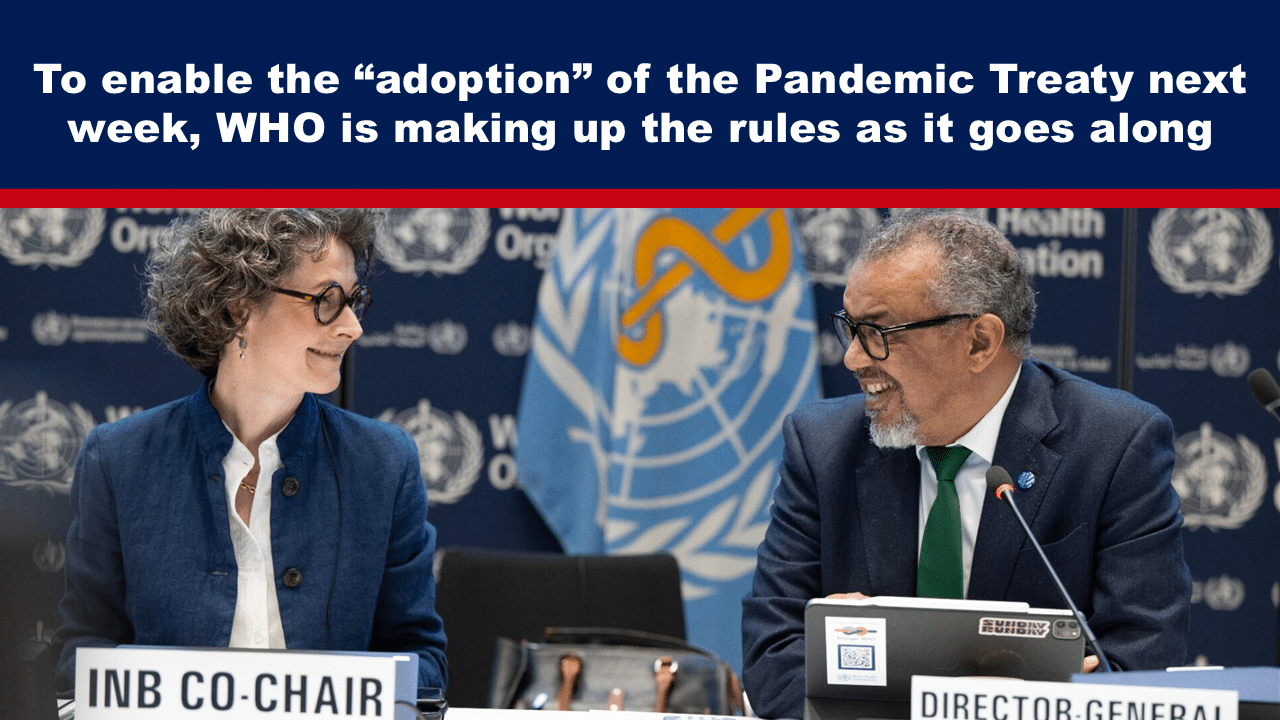To enable the “adoption” of the Pandemic Treaty next week, WHO is making up the rules as it goes along
The World Health Organisation’s draft Pandemic Agreement is being presented to the 78th World Health Assembly (“WHA”) for adoption next week. However, this “adoption” is not what it seems. A critical part of the agreement, the Pathogen Acc

We have tagged this article as propaganda as it imposes a serious spin on the topic.
If not more explanation provided, this article is included as propaganda because it shows clear manufacture from a government controlled dialectic,
where a topic is misdirected by some actors in order to mislead people during early stages of a narrative.
The World Health Organisation’s draft Pandemic Agreement is being presented to the 78th World Health Assembly (“WHA”) for adoption next week. However, this “adoption” is not what it seems.
A critical part of the agreement, the Pathogen Access and Benefit-Sharing (“PABS”) System is proving controversial and is still to be negotiated. So, to enable the Pandemic Agreement to be “adopted” next week, WHO has devised a workaround – WHO is making up the rules as it goes along.
Let’s not lose touch…Your Government and Big Tech are actively trying to censor the information reported by The Exposé to serve their own needs. Subscribe now to make sure you receive the latest uncensored news in your inbox…
WHO is now saying that if countries agree to “adopt” the Pandemic Agreement at the WHA, the Agreement will be deposited with Tedros Adhanom Ghebreyesus for countries to sign. But, the signing of the Agreement will not be possible any time soon.
If it is “adopted,” countries need to notify Tedros on whether they intend to accept the Pandemic Agreement within 18 months of the WHA. However, member states can only sign the Pandemic Agreement after an annexe for the much-contested PABS System has been adopted by a future WHA.
From the moment a member state signs the Pandemic Agreement, it will be expected not to undermine it. Does this mean that they cannot speak against it or criticise it? Is WHO using a top-down approach to censor governments, officials and advisors? Is WHO also expecting governments that sign its agreement to ensure that their citizens do not undermine the Pandemic Agreement as well? Censorship is the first sign that something bad is afoot.
After signing the Pandemic Agreement, the member states then need to take the appropriate action within their countries to ratify or adopt the agreement so it takes effect. In the UK, for example, the Public Health (Control of Disease) Act [1984] grants the Secretary of State for Health and Social Care, currently Wes Streeting, the power to adopt or give effect to such an agreement without reference to anyone else. To stop WHO’s nefarious pandemic agenda from being implemented in the UK, the section of the Act granting Streeting this power, section 45, needs to be repealed.
In the following, Meryl Nass shares an article published by Health Policy Watch and provides some comments on the “jumbled-up mess” WHO is creating and the sneaky changes to the voting process to enable the “adoption” of the Pandemic Treaty at next week’s WHA.
Note: The Pandemic Agreement has been called various names over the years. It has also been referred to as the Pandemic Treaty, Pandemic Accord and WHO Convention Agreement + (“WHO CA+”).
WHO Outlines Long Road Ahead Before Pandemic Agreement Comes into Force
By Meryl Nass
Apparently what the WHO bureaucracy decided they would be able to take a vote on the Pandemic Treaty at this WHA meeting, even before there is a (required by the treaty) PABS agreement on the pathogen lending library – but then they would not accept ratifications until after a PABS Annexe had been approved in the future. That way, they don’t lose momentum. Remember how the negotiators used to say about the Pandemic Treaty, “Nothing is decided until everything is decided”? Well, that got dropped like a hot potato.
But as I’ve told you, the WHO puppeteers HATE votes. And so, as I surmised, the bureaucrats have said that although a 2/3 vote is required to pass the treaty, they believe a “consensus” process will suffice instead. Those are much easier for them to arrange.
I imagine the bureaucrats were a bit frazzled since many are losing their jobs or being switched to new jobs, and they don’t know if they will be paid.
They are a sneaky lot. They were required to complete the treaty negotiations by this month, but that was impossible due to PABS (dis)agreements, so they created this jumbled-up mess in which you can vote on the treaty but you can’t ratify it, and it really won’t exist until the PABS section has been agreed.
I’m not sure all these machinations are kosher but no nations ever openly complain, so this is what we will see in Geneva over the next 2 weeks.
None of this requires that a Conference of the Parties be stood up to make the rules for how the treaty will operate. So, members will be signing a document whose actualities remain unknown. Never mind; by the time it comes into force all these diplomats will be in other positions.
Now, the article below reports the chronology of how the treaty will come into force with even more twists and turns. I don’t quite understand it. But in any event, this treaty is a long way off, if it ever will be settled.
Hopefully, under President Trump a real Treaty to ban gain-of-function and truly stop pandemics will be negotiated instead. I know people are working on it.
WHO Outlines Long Road Ahead Before Pandemic Agreement Comes into Force
By Kerry Cullinan as published by Health Policy Watch on 12 May 2025
The final draft of the pandemic agreement for the World Health Assembly (“WHA”) next week was published by the World Health Organisation (“WHO”) on Wednesday – along with a document outlining the long road member states still have to travel before it is enforced.
This follows the historic agreement reached on the text in the early hours of 16 April after three years of talks on how to prevent, prepare for, and deal with, future pandemics in an equitable manner – unlike what happened during covid when wealthy nations hoarded vaccines at the expense of low- and middle-income countries.
The procedural document outlining the steps to adoption, which will be done in terms of Article 19 of the WHO Constitution, makes sobering reading.
While the agreement needs a two-thirds vote to pass, “adoption of the text by consensus automatically fulfils this requirement,” it notes.
Once the WHA has adopted the agreement via a resolution, it will be deposited with the Secretary-General of the United Nations, who will ensure it is prepared in various languages for signature.
Member states are expected to notify the WHO Director General on whether they intend to accept the agreement within 18 months of its adoption by the WHA.
Still More PABS Negotiations
But member states’ signature of the pandemic agreement will only happen after the adoption of an annex on the much-contested Pathogen Access and Benefit-Sharing (PABS) System – a mechanism on how to share information about pathogens with pandemic potential and any possible benefits (such as vaccines and therapeutics) that might arise from sharing this information.
This annexe – called the PABS instrument – still has to be negotiated, and it deals with a range of issues including “the provisions governing the PABS System, definitions of pathogens with pandemic potential and PABS Materials and Sequence Information, modalities, legal nature, terms and conditions, and operational dimensions.”
This means the PABS can of worms will be reopened in the coming months and member states will once again have to find agreement on this highly contested subject.
Only once the annexe has been agreed, will the WHO Pandemic Agreement be open for signature by heads of state.
But even once the heads of state have signed the agreement, countries are not bound by its provisions.
Instead, by signing, a head of state would be “expressing political approval of the treaty concerned, and raises an expectation that the signatory will in due course take the appropriate domestic actions to become a contracting party.”
However, before domestic ratification, member states that have signed the treaty will be expected not to undermine the agreement.
Countries that have ratified the pandemic agreement will then be expected to deposit instruments of ratification with the UN Secretary-General and once 60 countries have done so, it will come into force and the first Conference of [the] Parties will be held.
The entire process is likely to take several years, during which time another pandemic can engulf the world.
About the Author
Dr. Meryl Nass is a physician and researcher who proved that the world’s largest anthrax epidemic, in Rhodesia (now Zimbabwe), was due to biological warfare. She had her license suspended for prescribing covid medications that worked. She posts invaluable information on her Substack page ‘Meryl’s Covid Newsletter’ and the website ‘Door to Freedom’. She also occasionally posts articles on a blog titled ‘Anthrax Vaccine’.
Featured image: French ambassador for global health Anne-Claire Amprou and WHO Director-General Tedros the Terrorist smiling at each other after the draft Pandemic Agreement was agreed. Source: World Health Organisation
The Expose Urgently Needs Your Help…
Can you please help power The Expose’s hosest, reliable, powerful and truthful journalism?
Your Government & Big Tech organisations
try to silence & shut down The Expose.
So we need your help to ensure
we can continue to bring you the
facts the mainstream refuse to…
We’re not funded by the Governmenrt
to publish lies and propagandas on their
behalf like the Mainstream Media.
Instead we rely solely on your support. So
please support us in ourt efforts to bring
you honest, relisble, investagative journslism
today. It’s secure, quick and easy…
Please just choose your preferred
method to show your support…
Read the full article at the original website
References:
- https://www.who.int/about/governance/world-health-assembly/seventy-eighth
- https://members.parliament.uk/member/4504/career
- https://expose-news.com/2025/04/22/whos-pandemic-treaty-is-not-binding-but/
- https://expose-news.com/?s=%22Pandemic+Agreement%22
- https://expose-news.com/?s=%22Pandemic+Treaty%22
- https://expose-news.com/?s=%22Pandemic+Accord%22
- https://expose-news.com/?s=%E2%80%9CWHO+CA%2B%E2%80%9D
- https://merylnass.substack.com/p/who-outlines-long-road-ahead-before
- https://substack.com/@merylnass
- https://healthpolicy-watch.news/who-outlines-long-road-ahead-before-pandemic-agreement-comes-into-force/
- https://healthpolicy-watch.news/author/kerry-cullinan/
- https://healthpolicy-watch.news/
- https://apps.who.int/gb/ebwha/pdf_files/WHA78/A78_10-en.pdf
- https://healthpolicy-watch.news/countries-say-yes-to-pandemic-agreement/
- https://apps.who.int/gb/ebwha/pdf_files/WHA78/A78_INF9-en.pdf
- https://merylnass.substack.com/
- http://doortofreedom.org/
- https://anthraxvaccine.blogspot.com/
- https://www.who.int/news/item/16-04-2025-who-member-states-conclude-negotiations-and-make-significant-progress-on-draft-pandemic-agreement
- https://expose-news.com/we-need-your-support/
- https://expose-news.com/2024/04/05/april-fundraising-campaign-24/
- https://expose-news.com/2024/10/17/the-expose-october-fundraising-2024/
- https://expose-news.com/asp-payment-box/?product_id=237456
- https://expose-news.com/asp-payment-box/?product_id=253886
- https://donate.stripe.com/4gw4iL2MOaLuaCAaEF
- https://www.buymeacoffee.com/dailyexpose
- https://expose-news.com/2025/05/15/wind-turbines-are-a-threat/
- https://expose-news.com/2025/05/15/royal-college-of-physicians-changes/
- https://expose-news.com/2025/05/15/chinas-vanishing-population/
- https://expose-news.com/2025/05/15/new-zealand-promotes-expensive-cancer-therapy/
